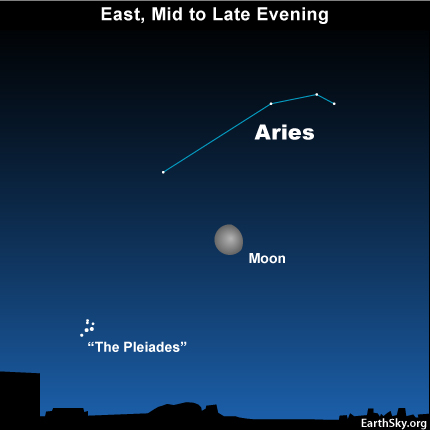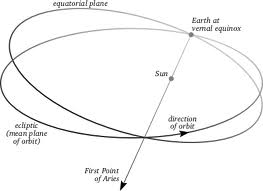Courtesy of EarthSky
A Clear Voice for Science
www.EarthSky.org

 In ancient times, the March equinox sun shone in front of the rather small constellation Aries the Ram. You can find this constellation ascending in the east around 9 to 10 p.m. tonight, the Ram’s starlit bust perhaps faintly visible to the upper right of the waning gibbous moon. Be forewarned. Aries is not conspicuous, especially in the moonlit glare. Tomorrow night, at this time, a smaller waning gibbous moon will shine right next to the Pleiades star cluster in the constellation Taurus.
In ancient times, the March equinox sun shone in front of the rather small constellation Aries the Ram. You can find this constellation ascending in the east around 9 to 10 p.m. tonight, the Ram’s starlit bust perhaps faintly visible to the upper right of the waning gibbous moon. Be forewarned. Aries is not conspicuous, especially in the moonlit glare. Tomorrow night, at this time, a smaller waning gibbous moon will shine right next to the Pleiades star cluster in the constellation Taurus.
In newspaper astrology columns and elsewhere, you often see Aries at the top of the Zodiac – the band of stars that provides a backdrop for the sun, moon and planets in the course of every year. Aries often comes first because this constellation marked the sun’s location at the time of the spring equinox between about 1800 B.C. and 1 A.D. Its relationship to the coming of spring gave this point vast significance to early astrologers. That relationship was so significant, in fact, that the point retains the name First Point in Aries – even though the actual location of the sun at the time of the spring or vernal equinox has shifted into the constellation Pisces, due to the Earth’s precession.
to the Earth’s precession.
Naturally, the point is still moving. According to astronomers, we will not enter the constellation Aquarius – and thus enter the Age of Aquarius – until several hundred years from now. It is good to recall here that these constellation boundaries were somewhat arbitrary at one time. The current boundaries for the constellations were decided upon as recently as the 1930s by members of the International Astronomical Union.
In other words, the first point of Aries – or the position of the March equinox point relative to the backdrop stars – slowly but surely drifts westward through the constellations of the Zodiac.
![]() Written by EarthSky
Written by EarthSky
Astronomy Picture of the Day from NASA/JPL
U.S. Naval Observator Astronomical Information center
The York County Astronomical Society